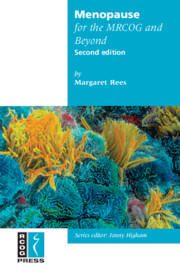Book contents
- Frontmatter
- Contents
- Preface
- Abbreviations
- 1 Definitions and controversies
- 2 Explaining risk
- 3 Systemic hormone replacement therapy
- 4 Non-HRT options for osteoporosis
- 5 Diet and lifestyle
- 6 Alternative and complementary therapies
- 7 Vasomotor symptoms, urogenital and sexual problems
- 8 Osteoporosis and autoimmune arthritis
- 9 Breast disease
- 10 Benign and malignant gynaecological disease
- 11 Premature menopause
- 12 Women with concomitant medical conditions
- Index
3 - Systemic hormone replacement therapy
Published online by Cambridge University Press: 05 July 2014
- Frontmatter
- Contents
- Preface
- Abbreviations
- 1 Definitions and controversies
- 2 Explaining risk
- 3 Systemic hormone replacement therapy
- 4 Non-HRT options for osteoporosis
- 5 Diet and lifestyle
- 6 Alternative and complementary therapies
- 7 Vasomotor symptoms, urogenital and sexual problems
- 8 Osteoporosis and autoimmune arthritis
- 9 Breast disease
- 10 Benign and malignant gynaecological disease
- 11 Premature menopause
- 12 Women with concomitant medical conditions
- Index
Summary
Many HRT preparations are available with different combinations, strengths and routes of administration. Various terms are used such as hormone therapy for estrogen therapy and EPT (estrogen and progestogen therapy) for combined preparations. Regimens may vary between countries.
HRT regimens
Hormone replacement therapy consists of estrogen alone in women who have had a hysterectomy but is combined with a progestogen in women with an intact uterus. Progestogens are given cyclically or continuously with the estrogen. Systemic estrogens can be delivered orally, transdermally (patch or gel) or subcutaneously (implant). Topical estrogens are given vaginally and these are discussed further in Chapter 4. Progestogens can be delivered orally, transdermally (patch) or directly into the uterus.
ESTROGENS
Two types of estrogen are available: synthetic and natural. Synthetic estrogens, such as ethinyl estradiol, are generally considered to be not suitable for HRT because of their greater metabolic impact except for women with premature ovarian failure (see Chapter 11). Natural estrogens include estradiol, estrone and estriol. These are synthesised from soya beans or yams and are chemically identical to the natural human hormones. Conjugated equine estrogens are derived from pregnant mares' urine. The active ingredients are primarily the sulphate esters of estrone, equilin sulphates, 17α-estradiol and 17β-estradiol.
Symptom control
Young women who experience a surgical menopause may initially need higher doses of estrogen to alleviate menopausal symptoms than their older counterparts; for example, 4 mg estradiol rather than 1 mg. Conversely, older women usually require lower doses to control their symptoms.
- Type
- Chapter
- Information
- Menopause for the MRCOG and Beyond , pp. 17 - 24Publisher: Cambridge University PressPrint publication year: 2008

